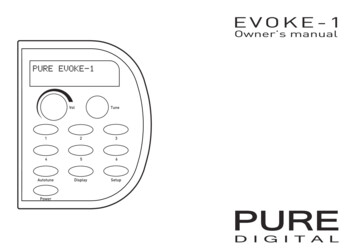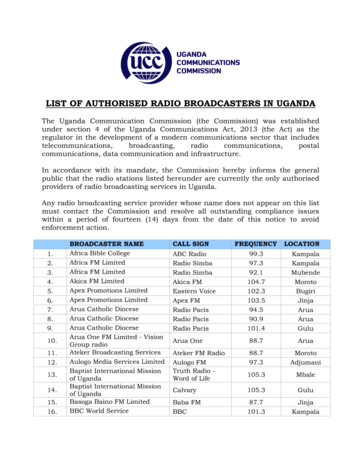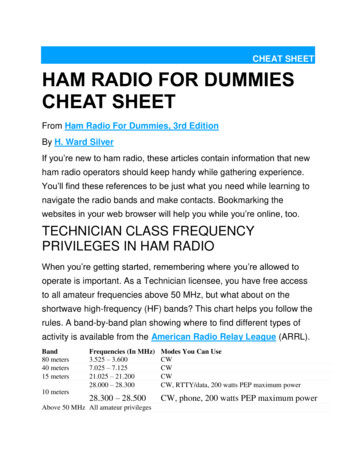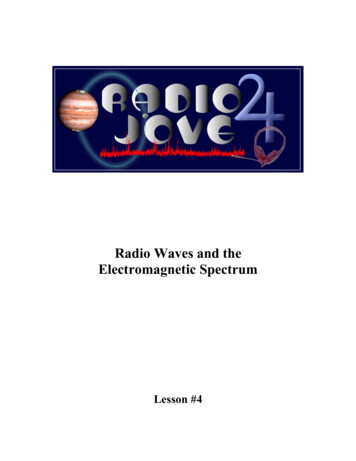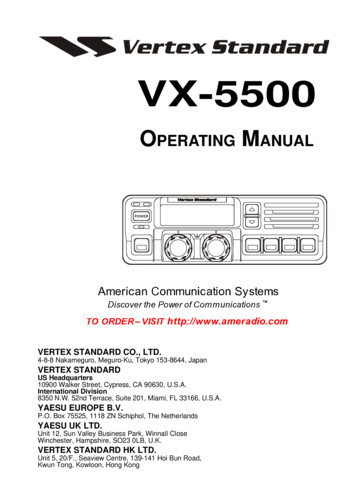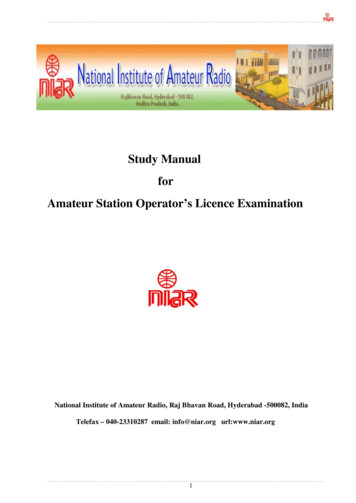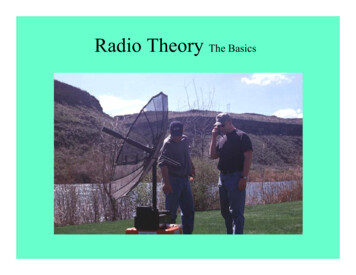
Transcription
Radio Theory The Basics
Radio Theory The BasicsRadio Wave Propagation
Radio Theory The BasicsElectromagnetic Spectrum
Radio Theory The Basics
Radio Theory The Basics Differences between Very High Frequency (VHF)and Ultra High Frequency (UHF). Difference between Amplitude Modulation (AM)and Frequency Modulation (FM). Interference and the best methods to reduce it. The purpose of a repeater and when it would benecessary.
Radio Theory The BasicsVHF - Very High Frequency Range: 30 MHz - 300 MHz Government and public service operate primarily at 150MHz to 174 MHz for incidents 150 MHz to 174 MHz used extensively in NIFCcommunications equipment VHF has the advantage of being able to pass throughbushes and trees VHF has the disadvantage of not reliably passingthrough buildings 2 watt VHF hand-held radio is capable of transmittingunderstandably up to 30 miles, line-of-sight
Radio Theory The BasicsVHFABSOLUTE MAXIMUM RANGE OFLINE-OF-SITE PORTABLE RADIOCOMMUNICATIONSS0 MILE02TUBOSMIT ANARTz CAN165 MH
Radio Theory The BasicsUHF - Ultra High Frequency 300 MHz - 3,000 MHz Government and public safety operateprimarily at 400 MHz to 470 MHz forincidents
Radio Theory The BasicsUHF - Ultra High Frequency 400 MHz to 420 MHz used in NIFC equipmentprimarily for logistical communications andlinking Advantage of being able to transmit greatdistances (2 watt UHF hand-held can transmit 50miles maximum line-of-sight in ideal conditions) UHF signals tend to “bounce” off of buildings andobjects, making them effective for incidents inurban areas
Radio Theory The BasicsUHF
Radio Theory The BasicsAM - Amplitude Modulation Government and public safety that operateprimarily 118 MHz to 138 MHz use amplitudemodulation for air operations Major disadvantages are that AM is extremelysusceptible to “noisy” interference from static,lightning, and other disturbances thepropagation properties also limit the effectivedistance Referred to as “victor” frequencies by theaviation community
Radio Theory The BasicsFM - Frequency Modulation Used extensively in land-mobile radio andon incidents for command and logisticalnets Advantage: not easily accessible toatmospheric and manmade interference very little noise
Radio Theory The BasicsInterference Primarily caused by other radio equipmentoperating on, or close to the samefrequencies Reduce interference by physicallyseparating the radio equipment
Radio Theory The BasicsInterference & Repeaters VHF repeaters should be placed several hundredyards apart or should be shielded from each otherby the terrain VHF and UHF repeaters on the same site– At least 10 yards separation– Directional antennas will help reduce interference evenmore Vertical separation vs. Horizontal separation
Radio Theory The BasicsShielding EquipmentEXISTINGANTENNASROCK OUTCROPPORTABLE REPEATERS
Radio Theory The BasicsAntenna Orientation Critical for the proper operation of theantenna– A hand-held radio lying on a vehicle seat is lesseffective than holding the hand-held upright The higher the antenna is above thesurrounding terrain, the farther the signalwill travel
Radio Theory The Basics50 FT.ANTENNA2,000 FT. MTN.COULDTALKUPTO70MILESCOULD15 MTALK UILE P TOS.FLAT DESERT, 100WATT RADIOS, HI-BAND.
Radio Theory The BasicsDirectional Antennas Radiate and receive the majority of the radiosignal in one direction The signal from directional antennas travel fartherby concentrating or reflecting it in one direction Directional antennas provide isolation frominterference by limiting receiving signals to aconcentrated area The higher the signal is above the surroundingterrain, the farther the signal will travel
Radio Theory The BasicsRepeaters - VHF and UHF Repeats the signal by receiving on onefrequency and re-transmitting on a differentfrequency. For example, a repeater receivesthe radio signals on frequency 170.450, andthen transmits the signal on 168.100 Used to cover greater distances when lineof-sight is not possible to cover the terrain
Radio Theory The BasicsRepeatersREPEATER ONCOMMAND 2FREQUENCIES.REPEATS MESSAGE ON168.100 MHz - CHANNEL 4CHANNEL 5TRANSMITS ON170.450 MHzCAN'T TALKTHROUGH MOUNTAINTHESE TWO CAN TALKDIRECT USING CHANNEL 4 168.100 MHz.
Radio Theory The BasicsTroubleshooting Problems Can’t hear repeater Rpt. Signalchoppy/intermittent Unintelligible audio Low audio Rpt. Squelches Rpt. Locks Up No Tx or Rx Equipment automaticallyblows fuses Hearing adjacent traffic Rpt. Quits at specifictimes of day Remote does not work Aircraft radio link doesnot work Handheld radio does notwork
Radio Theory The BasicsTroubleshooting Causes Dead batteryLoss of coverageWiring shortageTransmitter failureReceiver failureAntenna installation failureLow or no modulationLow battery voltageIncorrect frequencyRadio not operatingproperlyIncorrect ChannelDamage in transportHeat / Weather Batteries incorrectly wiredTransmit switch in OFFpositionTheft of EquipmentAnimal DamageInterferenceIntermodulationKeyed radio (hot mic)Audio levels not set correctly
Radio Theory The BasicsRadioUse andIncidentSafety
Radio Theory The BasicsIncident Safety Concerns LightningDriving hazardsHigh voltage transmission linesElectromagnetic Radiation
Radio Theory The BasicsIncident Safety Concerns PPEHazardsBasic and site specific hazardsHeavy equipment
RADIO Communications & ICS
Radio Communications PlanICS 205
Radio Theory The BasicsOTHER ISSUES:- APCO- Encryption- NTIAQUESTIONS?
Ł Low audio Ł Rpt. Squelches Ł Rpt. Locks Up Ł No Tx or Rx Ł Equipment automatically blows fuses Ł Hearing adjacent traffic Ł Rpt. Quits at specific times of day Ł Remote does not work Ł Aircraft radio link does not wor

